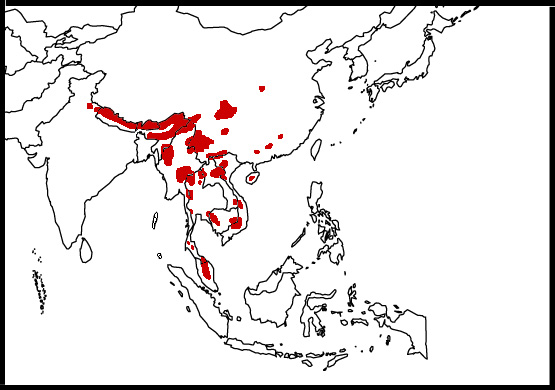Alternative name: Blue-winged Siva
- Minla cyanouroptera
Siva cyanouroptera
Identification
With 14 - 15.5cm a rather small, pale brownish Babbler1:
- Longish, square-tipped blue tail
- Largely blue wings
- Whitish supercilium
- Bluish-grey crown with dark lateral border and streaks on forecrown
The female has a slightly less blue crown. Juveniles have browner, less streaked crowns.
The subspecies differ in the streaks on the crown and the colour of the crown and upperwings. Orientalis differs most, having grey-blue wings and a blackish-grey tail.
Distribution
| Found in the mountains of SE-Asia from the Himalayas (India, Nepal, Bhutan) east to S China (including Hainan) and south to Myanmar, Thailand, Laos, Cambodia, Vietnam and the Malay Peninsula. No recent records in Bangladesh, but common in parts of its range. Population of captive origin in Hong Kong.1 | |
| Legend • M. cyanouroptera; year-round |
Taxonomy
Differs vocally from other Minlas and there is in fact no evidence for a closer relationsship with the genus Minla. Has therefore been placed in its own genus Siva and also renamed as Blue-winged Siva. Probably closer related to Mesia and Leiothrix.1
Clements2 accepts 8 subspecies:
- M. c. cyanouroptera in the Himalayas
- M. c. aglae in the Hills of Assam and Myanmar
- M. c. sordida in Myanmar and Thailand
- M. c. wingatei from Myanmar east to Thailand, Indochina and S China (including Hainan)
- M. c. croizati in SW China (Sichuan)
- M. c. rufodorsalis in the mountains of SE Thailand and SW Cambodia
- M. c. orientalis in S Vietnam
- M. c. sordidior in peninsular Thailand and Malaysia
Other authorities treat croizati as synonymous with wingatei and accept only seven subspecies.1
Habitat
Open broadleaf evergreen forest, pine forest and mixed forests. Also forest edge, secondary growth, bamboo and cultivated land near forest. Found between 250m and 3000m.1
Behaviour
Diet
Feeds on insects, berries and seeds. Forages in canopy and middle-storey, also in bushes and forest edge.
Usually seen in flocks of 5 to 20 birds and very often in bird waves, together with other Babblers.
Breeding
Breeding season from March to August. Co-operative nesting reported. The nest is a small cup made of bamboo and other leaves, placed in a bush or a streambank, about 2m above ground. Lays 2 - 5 deep blue or bluish-white eggs.
Resident with some altitudinal movements in the Himalayas reported.1
References
- del Hoyo, J., Elliott, A. and Christie, D.A. eds. 2007. Handbook of the Birds of the World. Vol. 12. Picathartes to Tits and Chickadees. Barcelona: Lynx Edicions. ISBN 84-96553-42-6
- Clements James F. 2007. The Clements Checklist of Birds of the World. 6th ed., with updates to October 2007. Ithaca: Cornell University Press. ISBN 9780801445019
Recommended Citation
- BirdForum Opus contributors. (2024) Blue-winged Minla. In: BirdForum, the forum for wild birds and birding. Retrieved 19 May 2024 from https://www.birdforum.net/opus/Blue-winged_Minla





